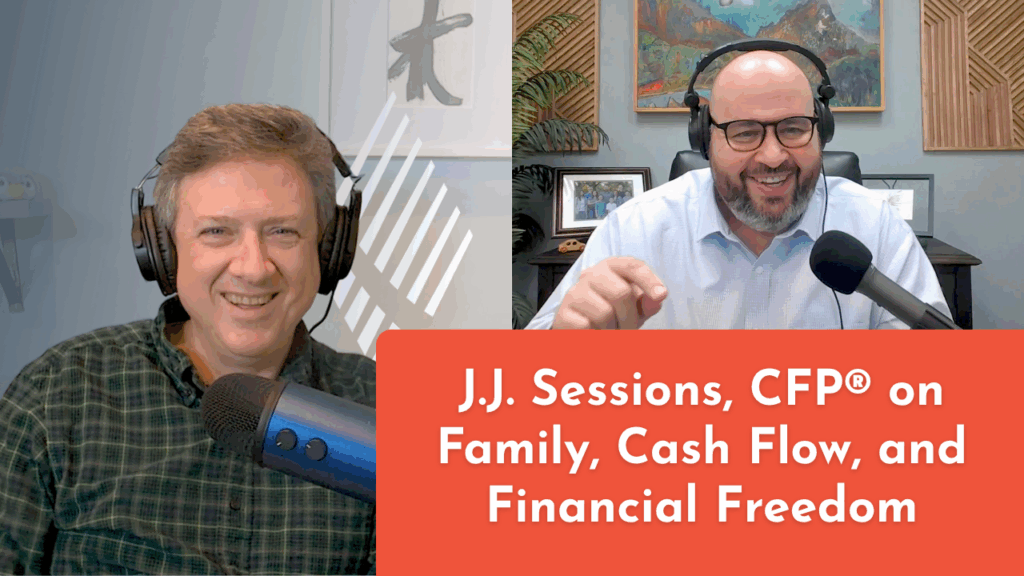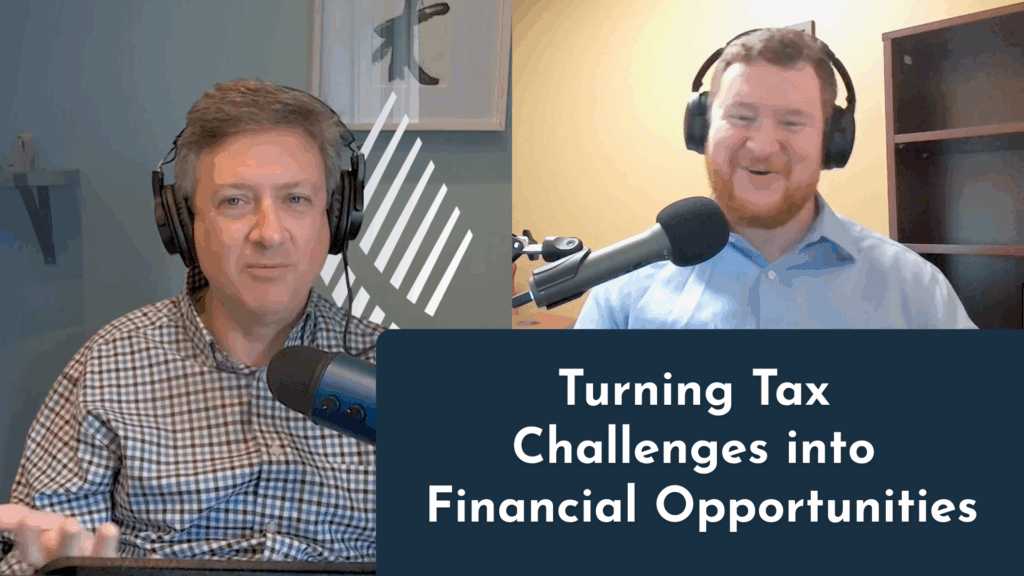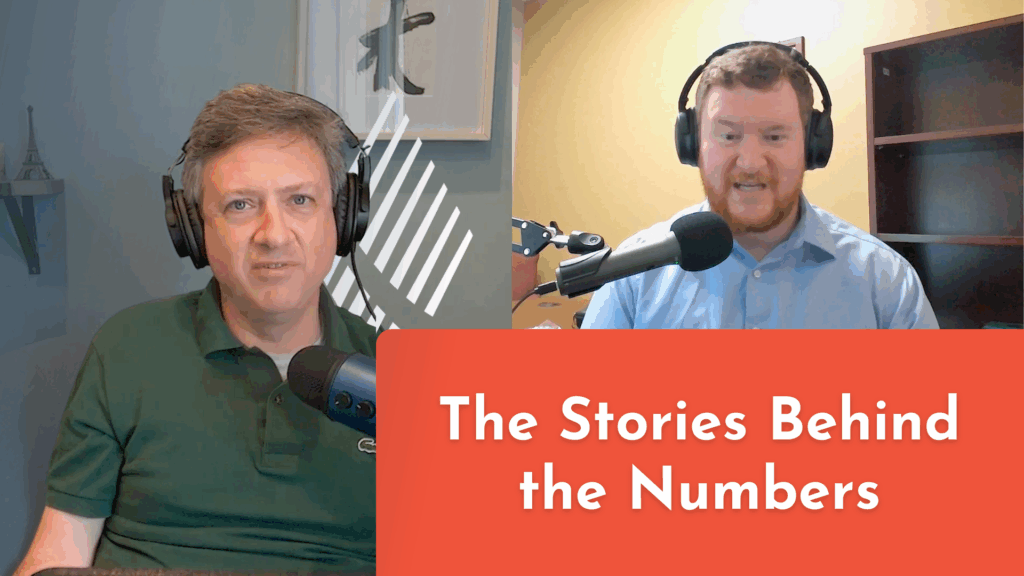[00:00:00] Intro: Every number on a balance sheet tells a story, late nights spent building something meaningful, the risks taken, the difficult conversations, the lessons learned along the way. But true wealth is not measured in dollars. It’s woven into the stories that we create, the experiences that shape us, and the memories that outlive us.
Welcome to the Living Beyond Numbers Podcast with Jude Boudreaux from the Planning Center. This show is not about spreadsheets and financial jargon. It’s about real conversations and powerful stories. That help you align your money with your values, your dreams, and your legacy, because at the end of the day, it’s not about how much you have, it’s about the life you wanna live and the stories you leave behind. Now onto the show.
[00:00:49] Jude Boudreaux: Welcome everybody. Thanks for joining us for another edition of Living Beyond the Numbers podcast. I’m your host, Jude Boudreaux, with Caleb Arringdale, our director of positivity, [00:01:00] and we’re joined today by Rob Baner, who’s the head of our tax group, one of our partners here at the planning center, and, uh, really, uh, colorful and interesting character.
So welcome Rob. Glad you’re on here today. Yeah, thank you. So Rob, uh, we’ve gotten to work together for a long time, but maybe shared a little bit about how, you know, you came to be a part of the planning center.
[00:01:19] Rob Baner: Sure, absolutely. Well, uh, I’m a graduate of the University of Iowa. I did my undergrad and my master’s there, uh, in accounting.
And I came back to the Quad Cities area where I grew up after college, joined a full service public accounting firm where I did quite a bit of, uh, audits of nonprofits and taxation of various different kinds of entities. And I knew mattsson very well growing up. And. Through that time were musicians together and eventually started chatting with the Planet Aid Center and ended up joining the team back in 2015.
[00:01:55] Jude Boudreaux: Yeah. Well, and yeah, and Rob’s, uh, head of our tax group and, uh, I [00:02:00] often jokingly say like, it’s, it’s hard to find accountants who are good at talking to humans, but our accounting team is all really good at that. And, um, you know, we, there’s a big part of the, kind of the planning experience with us to, you know, be involved in conversations and what’s happening with clients throughout the year, not just doing taxes in the spring.
So, Caleb, maybe you wanna take it away since you know, you guys work so closely together. Rob is my boss.
[00:02:24] Caleb Arringdale: So I guess first of all, oh boy. First of all, I’d say obviously you and Matt Stevenson played in a band for many years together. Why is it, do you think so many people here at the Planning Center are musicians and like musicians at like a pretty high level?
[00:02:38] Rob Baner: Yeah, I think it’s really cool. Uh, I’m not sure why, but I do know that music can just create this special experience. It can really, uh. Give you a lot of meaning in different areas, whether it’s, uh, the community aspect, the conversation aspect, or [00:03:00] that pursuit of a discipline and mastery, uh, or exercising those different sides of your brain for different things.
Uh, so, so I think that just can work well at people, you know. Working together.
[00:03:18] Caleb Arringdale: Yeah, I mean, in music you’re in ensemble usually, right? If you’re in a band, you’re in a group, and that’s what we do as well. I totally agree. But you know, as much fun as music is, let’s talk taxes. I mean, you know. Sure. So obviously the new or the current tax thing is this new tax law, right?
Do you wanna tell us a bit about it? Give us kind of the quick rundown, like what is it?
[00:03:38] Rob Baner: Absolutely. So the new tax law, the one big beautiful bill, or the HR one, it’s been called a few things that was passed back in July. Uh, and so we’ve been really getting to work on studying that and understanding things.
Some things we’re certainly waiting for clarity on. I have really been able to start grasping some of the key points and planning ideas around that. Uh, so I think [00:04:00] one of my biggest takeaways is, you know, back in 2018 we had that Tax cuts and Jobs Act passed, and that was a pretty big change compared to the 2017 laws.
And a lot of this new bill is just going to extend. Many of those same provisions. So before the bill was passed, we had a reality where maybe some or all of these tax cuts and Jobs act provisions would be gone after toy 25 and we could see a reversion to toy 2017 rules in toy 26. That’d be a pretty big change.
Now, almost everything are many. Provisions are simply extended, slightly expanded, slightly changed. So I’d say for a lot of people it’s kind of a continuation of the norm that you got used to back in 2018.
[00:04:50] Caleb Arringdale: Yeah, I totally agree. I had a tax school instructor say that the old tax law, the TCJA, that 2018 law was like [00:05:00] someone put a trench code over the old tax law, whereas, so you really had to know both.
Whereas now we just have like one tax law, so it’s. In some ways it’s probably slightly simplified, but there are also a bunch of new provisions. So I guess thinking of 2025, right? What are the biggest changes for this year that are in the tax bill?
[00:05:20] Rob Baner: Yeah, I think the few key things to keep in mind, uh, the first one is that when we claim a deduction on our tax return, either we get a standard deduction, which is around 30,000 for married fellon joint.
Or we get an itemized deduction, which can be a culmination of a bunch of different things. For example, if you have a lot of medical expense that might add to your itemized deductions, if you have mortgage interest and if you have state and local taxes. And charity. Those are the main ones, and usually medical isn’t high enough to be included in that anyways.
It has to surpass a certain threshold, and so one of the [00:06:00] biggest changes here is the state and local taxes deduction, also known as the salt deduction that was limited to $10,000 back in 2018. With that. TCJA law and this new law is going to expand that deduction up to $40,000 if you’re under income limits.
So for certain people who have high enough salt or state local tax deduction to help them itemize instead of claiming the standard deduction, and if their income’s not over the limit, they might see tax savings from this higher deduction.
[00:06:39] Caleb Arringdale: We heard a lot about this whole salt cap. It was a lot of discussion.
What, what taxes are part of this? What’s actually included in in salt?
[00:06:47] Rob Baner: Yeah. So SALT includes, uh, your real estate taxes if you own your home, and it also includes your state income tax, if your state has income tax. [00:07:00] Uh, or it can be state sales tax. As a, uh, deduction instead of the state income tax if it’s higher.
[00:07:10] Caleb Arringdale: Perfect. The other big thing that got bandied around a lot was the idea that, uh, like social security would not be taxed. How do, how does the law actually describe that? Like, what, what’s, what’s actually happening?
[00:07:21] Rob Baner: So moving on to the next big change is that one where we have this new deduction that’s called the senior deduction, and it is not necessarily related to social security income.
It is a deduction you could qualify for if you’re age 65 or over. Whether or not you’ve claimed social security income. Uh, so it’s not tied to that in any way. It doesn’t impact the amount of social security that is included in your gross income. And uh, and that’s also separate from your itemized deduction or your standard deduction.
So whether or not you itemize [00:08:00] or claim the standard deduction, you can get this new. Senior deduction if you’re age 65 or older, and if your income is under certain limits, so not everybody is going to qualify for this deduction as well. The amount of the deduction is $6,000 per spouse who is over that age limit.
So. If we have somebody just under the income limit, which starts to phase out at $150,000 of income for married filing joint, they would be in the 22% tax bracket if they’re both age 65 and over. So they get this deduction and they’re not phased out of any of it. The maximum benefit is $12,000 times 22%, and that is about $2,600 of maximum tax savings.
[00:08:53] Caleb Arringdale: Any other big deductions, any other changes for 2025 we’re looking at?
[00:08:57] Rob Baner: Yeah, so I think the three, there’s three more that are [00:09:00] also all deductions that I think are worth, worth mentioning. Uh, not gonna be applicable for everybody, but we have that TIPS deduction. They talked a lot about the no tax on tips.
Uh, and so what this is, it’s not taking tips out of your income. Tips will still be part of your income. It’s a separate deduction that you may qualify for against your income. So that’s more important for determining things like what is your total income or what is your adjusted gross income? So kind of a technical thing.
But uh, if you have tips, income, and if you’re under income limits, you could. Get qualified for that deduction up to 25,000 of tips. But I think a really important thing to keep in mind is, I know a lot of people are like, Ooh, I could just say everything’s tips or build in mandatory tips into my, uh, my income stream or whatever it is, that there are going to be a lot of rules or there are a lot of rules that [00:10:00] are going to limit kind of the gaming of that system.
And it’s only gonna be, uh. Applicable for industries that regularly have tips as part of that industry. I believe the IRS is going to release a list of these industries, so I wouldn’t count on people getting particularly creative to take advantage of this deduction unless it really is the nature of.
That income.
[00:10:25] Jude Boudreaux: Yeah. So no tips for your tax professionals, right? Yeah, exactly. We can’t say, hey, 30% tip on a tax return, guys. Oh yes.
[00:10:33] Rob Baner: Yeah. So yeah, a lot of people cannot say, I’m gonna reduce all of my fees by 80% and now charge a whatever tip on top of it, that that kind of thing won’t fly. Of course.
[00:10:45] Caleb Arringdale: Bummer.
No.
[00:10:46] Rob Baner: The next deduction would be overtime deduction. Uh, so if. Your Underlit income limits. All of these new provisions, or most of these new provisions have income limits, so not everybody will qualify, [00:11:00] uh, but over time we’ll have a deduction as well. Similar to tips over time would still be part of your income.
But you’d get a deduction that you could qualify for the, it’s only the like and a half component. So when you get overtime pay and you have a higher rate of pay, only that increase in your rate of pay can be eligible for deduction, not all of the pay. That’s for the overtime hours.
[00:11:23] Caleb Arringdale: Got it.
[00:11:24] Rob Baner: So the third one would be this car loan interest deduction.
And that one’s also a little misleading. It’s only new cars. Of 2025 onwards. So your old cars that have loans, that interest would not qualify. And there’s rules about being assembled in the US and I think they’re gonna have a website, or they might already have a website where you actually look up the VIN to determine if that vehicle’s qualified for this deduction and this deduction, just like the senior deduction, [00:12:00] the tips deduction, and the overtime deduction.
None of these are. Itemized deductions where you only claim them if you itemize. They’re separate from itemized or standard deduction, so you deduct them in addition to your standard deduction or your itemized deduction.
[00:12:18] Caleb Arringdale: No, great. Obviously this has been, you know, thrilling for a tax person, so for non-tax people this can still be pretty impactful.
So this is pretty good stuff. Um, finally, so that’s the big things. 2025, I’ll say. What about 2026? Anything we’re looking forward for next year?
[00:12:34] Rob Baner: Yeah, it just before I move on, one other just overarching comment is that all of these provisions that I’ve talked about so far. I think for the average client of ours, usually it’s gonna have a modest impact, uh, rather than a really significant impact except for their, you know, there’ll be very specific situations where they might be in that goldilock zone for one of these new provisions, [00:13:00] and then that type of person might see a, uh, significant benefit.
So that’s something. That, you know, we’re always looking at proactively, uh, with the work work we do with our clients.
[00:13:12] Jude Boudreaux: Yeah, I think it’s important to hit on that too though. ’cause I, I like to tell clients, uh, we wanna make tax aware choices and not tax driven ones, right? So going out to buy a new car might be fun, but it’s not, you know, and may maybe save you a little bit on taxes, depending on, you know, if it qualifies for these provisions.
But it’s not enough to say like, well, you should just go buy a new car for tax purposes.
[00:13:36] Caleb Arringdale: Yeah. And then, uh, I guess now let’s move forward. 2026. Yeah. Yes. What are we looking like?
[00:13:42] Rob Baner: Yeah. Uh, so there’s quite a few more provisions in 2026, and I didn’t cover everything in 2025, just kind of the highlights, the most important ones.
So I’ll go through a little bit of a laundry list of 2026 of what I think might be the key things to keep in mind. [00:14:00] Uh, so. I think one is that under the old rules, the estate exemption was going to go down after 2025, and with this new law, the estate exemption is going to instead. Essentially increase, but, you know, as if it were inflation adjustments to the old 2018 rule.
So we’re gonna have a 15 million estate exemption beginning 2026, making a, what this relates to is a estate taxation. So if we have an estate that’s worth 15 million or less, most likely you would not be subject to federal estate tax. And, and that’s also per spouse. So if we have a married, uh. Taxpayers and one of them passes away, or we’d have 30 million total between the two of them.
If one of them passes away and if they file for the what’s called dei, deceased spouse’s [00:15:00] unused exemption, then that deceased spouse’s exemption can be claimed. By the surviving spouse in the future, leaving the surviving spouse with a, a state exemption of 30 million under current law. And again, these laws can always change.
So it could be 15 million now, and you just, you don’t know what it will be when you might pass away. So there’s always an element of uncertainty. The longer term we look.
[00:15:27] Caleb Arringdale: I think that’s an interesting one because for like years now, we haven’t really worried about that for most people. You know, not too many people have estates over $30 million, but for those who were, you know, obviously it was a big deal, but most people aren’t above that.
But if it had dropped pretty pretty precipitously all of a sudden, this would’ve been interesting. Again, a lot of planning to be done, but this really simplifies it.
[00:15:49] Rob Baner: Yeah, I, I think it just speaks to. There will always be some uncertainty about the, the bets we’re making now are about things that may not occur for 30 years, [00:16:00] and so it just always takes some intentionality around the decisions we make.
And someone, a surviving spouse may not be particularly interested in filing for this to sue ’cause there’s a cost and a process to that. But. Let’s say 30 years down the road. For some reason, we have a state exemption that’s very, very low. They might wish they had filed for this exemption.
[00:16:25] Jude Boudreaux: I know I’m familiar with situation where, uh, a family is, you know, going through and filing this exemption, and it’s a bit of a process to do with the estate attorney and the tax folks to get all that recorded.
But it’s, um, well it’s just an ounce of prevention for a pound of cure if the exemption changes dramatically. You know, when I started in the industry, the state exemption was $500,000. Uh, so it was a very common thing for people to be dealing with estate taxes, uh, and. Probably unlikely that we maybe head back there, but I also imagine it’s maybe unlikely we’re staying in this 15 to $20 [00:17:00] million range for a very long time either.
Uh, so I just think it’s, if a family has means why is, uh, the investment of energy to, you know, file that DSUE and to make sure you’ve got that exemption in your pocket.
[00:17:13] Rob Baner: Yeah, absolutely. So then kind of moving on to some other provisions in 2026. The next ones are all around itemized deductions.
[00:17:22] Caleb Arringdale: Sure.
[00:17:22] Rob Baner: So moving on with another charity item is, uh, some of our itemized deductions like medical are subject to what’s called a floor in taxation, where the reduced based on your income before the excess amount is.
Included on your itemized deductions. So medical, as an example, is reduced by 7.5% of your income before it is included in your itemized deductions. Beginning 2026 with the new law, our charitable donations will be subject to half a percent haircut or floor [00:18:00] before they’re included at itemized deductions.
So if you had a. Adjusted gross income of a hundred thousand, then your charity would be reduced by $500 before the amount over that is included on your itemized deductions. So a little less, uh. Tax benefit to charitable donations in 2026 from that, uh, floor rule. And then similarly, for higher income tax payers who are in the highest tax bracket, the 37%, there’s going to be a new provision in 2026 that reduces the tax benefit of all of your itemized deductions based on.
Uh, the way, the best way to say it is as if your itemized deductions were deducting at your 35% bracket instead of your 37% bracket. So that little Matthew there, but that’s a, basically, it makes it so you can’t get the benefit of [00:19:00] your 37% bracket on those deductions. You get a cap of a 35% benefit, saving 35 cents on the dollar instead of 37 cents on the dollar.
So overall 2026. We have a few provisions that are gonna give us a slightly reduced benefit to itemized deductions for high income taxpayers.
[00:19:21] Jude Boudreaux: I think that’s part of the, maybe the planning opportunity that people should explore with their tax professionals is, you know, is it better for me to give in 2025 and perhaps give more than to give in 2026?
[00:19:35] Rob Baner: I think that’s a great point. I’d, I’d love to expand on that a little bit. It, I’d say that for those who are really considering large, uh, philanthropy gifts in 20 or in anytime soon, uh, if you wanted to consider funding a donor advised fund with a very sizable donation, uh, or if we were looking at.
Pairing some strategy such as [00:20:00] recognition of income with an offsetting charitable donation strategy. Commonly we might see, uh, Roth conversions being considered for this type of strategy. Then 2025 is going to be a little more tax efficient for most people. To complete these charitable goals in 2026.
And this plays into another concept called lumping. So lumping is when, let’s say, uh, the standard deduction is around 30,000, and my itemized deductions are usually around 28,000. So I get no benefit of those itemized deductions each year ’cause they’re just slightly too low. With a lumping strategy you might consider condensing.
Multiple years of those deductions into one year. So it rises way above the threshold to itemize instead of claiming the standard deduction. And then in those other years, you are claiming the standard [00:21:00] deduction. So charity is the most common way to accomplish that. You might do three to five years worth of charitable giving goals in one year.
Whether to the charities or to a donor-advised fund. And then in those other years, uh, you’re, you’re dripping money to charities from the donor-advised fund or have already met your goals from a via the current year donation, and that kind of gives you a tax savings over a longer period of time.
[00:21:28] Caleb Arringdale: The long story short on that is if you wanna do that, maybe consider 2025.
2026 is still good. But yeah, this year talk. Talk about the potential of accelerating that
[00:21:40] Rob Baner: a little bit better. Tax break this year for most people.
[00:21:44] Caleb Arringdale: Any other big 2026 items.
[00:21:46] Rob Baner: Absolutely. So these, you know, these won’t be relevant for everybody, but it just depends on circumstances. But we have a variety of other things.
One is 5 29 plans will become a little more flexible for how they can [00:22:00] be used. And what a 5 29 plan is, is it’s a, uh, a tax preferred savings vehicle for. College essentially. But now it’s a little more flexible. So you give, you donate money to a, you contribute money to a 5 29 plan, and you have a beneficiary such as your child or grandchild.
Commonly you get a state deduction for that contribution, depends on the state, and then that grows tax-free instead of the earnings being taxable every year. And as long as it’s used for qualifying expenses, those distributions out of the account. Are also tax free. So that’s a great way to fund college.
Uh, and now we’ll have a little more flexibility beginning 2026. Another item is that most of the energy credits that we’ve had for a few years, uh, some of them for longer, uh, most of those are repealed as of 2026. So ending in 2025, the electric vehicle credit ending [00:23:00] even earlier September of 2025. So we, uh, won’t have most energy credits in 2026 onward.
Uh, we also have. For those on the state health insurance programs, uh, the bronze plans will now be eligible for HSA contributions and. HSA is a health savings account. If you are in a high deductible health plan, then you could contribute money to these HSA accounts and it’s a deductible contribution or a, or a tax-free benefit from your employer.
Uh, now they’re going to include bronze plans, which are technically not high deductible health plans into the eligible type of plan for these HSAs. Uh, and that the. Employer Dependent care benefit is going to go up from 5,000 to 7,000. So if you have, [00:24:00] uh, an employer, uh, dependent Care Benefit program, basically that’s the employer contributes to the saving or can pay or.
Use part of your salary to pay for dependent care costs for your children. That amount’s going slightly up so it can get a little better. Tax break there. There’s additional loss limitations on gambling income, making gambling even more tax inefficient. They don’t have very good lobbyists, so that’s gonna, uh, come into play for some gamblers.
They’re increasing the business meals deduction. This is for businesses from 50% to a hundred percent, so get a little better deduction for business meals. Uh, and one other one that I think is kind of interesting for some people is. We’ve had these 10 90 nines that we sometimes have to file. If you’re paying somebody more than $600 a year in your trader business, you have to issue [00:25:00] this 10 99 NEC or 10 99 MISC.
Miscellaneous, though that threshold is going up from 600. To 2000, so have less of these forms being issued. There’s also similar rules around 10 99 ks for people who have all of those online transactions, uh, and credit card transactions. Those reporting thresholds are also going up. We’ll see fewer of those forms issued.
[00:25:27] Caleb Arringdale: I think that one’s. It’s kind of a sleeper, but I think that’s actually one that could be really interesting for people. Just because for some people who are paying someone, you know, seven, $800 and they’re always like, oh, do I have to fill out this form? And we’re like, yes, you do. Now they don’t have to.
And there’s a surprising number of people kind of under that thousand dollar limit. So I think this actually will re reduce some compliance costs for people. So, eh, that’s kind of a benefit for, for, for several people actually.
[00:25:53] Rob Baner: Yeah. Yeah. It’s fascinating. Um,
[00:25:56] Caleb Arringdale: yeah.
[00:25:56] Rob Baner: One other item that this is, could be its own [00:26:00] topic and would be for later, but they have this new Trump account as part of the, the legislation.
And we’re waiting on quite a bit of clarity from the IRS on how exactly Trump accounts will work. But for now, the best way to think of it is beginning next year, 2026, uh, it will be a potentially tax. Favored savings vehicles for newborn children with a variety of rules around how contributions work, how distributions work, what it can be invested in is limited and we’re waiting for quite a bit more guidance to, to see exactly how that’s gonna function and, and when it might make sense and when it might not.
[00:26:44] Caleb Arringdale: Yeah. Point. Because obviously Trump. A great example of this, but so many of the things we’ve talked about, we think we know how they’re going to work or the IRS has, has issued limited guidance on it, but we really don’t know yet. There’s [00:27:00] so much gray area out there still so much. We’re waiting on actual rules, actual instructions and tax forms on that.
Some of the stuff we’re just, we’re just gonna have to wait and see how it really plays out. So we, I mean, we’ve taken several classes we’re trying to learn, but. Some of it literally there is no law yet. So I guess we’ll, we’ll find out hopefully shortly.
[00:27:20] Jude Boudreaux: I think it’s always fascinating ’cause you have the law that is kind of the guideline and then the rule making packages that get ’em out from the different agencies are this kind of additional parts of the law.
But it often gives us the details we need to really understand something.
[00:27:34] Caleb Arringdale: Okay. So we’ve talked about all these different tax provisions. In your experience for like the typical family, what sort of planning strategy should they keep in mind? Where, what are the new ideas about that?
[00:27:44] Rob Baner: Yeah, I think one of the most important points to keep in mind with the new law would be.
Many of these provisions have income-based phase outs. And so what that means is like as an example, this new salt cap, the [00:28:00] expanded deduction for state and local taxes phases out over 500,000 to 600,000 of income of modified adjusted gross income. So, and then the same goes for. The senior deduction has a phase out range, its own phase out range.
The the tips, the overtime, the many of these provisions have these income phase out ranges. So if you are someone who’s in or near one of these phase out ranges, and if you’re planning around income recognition, whether that be selling a stock that has a lot of. Unrealized capital gain or considering a Roth conversion strategy where you trigger income.
Now as part of a long-term planning process, uh, these phase outs can cause magnified tax rates on these income events. So we have to be careful about saying [00:29:00] what is a person’s marginal tax impact of this income event. It might not just be their marginal tax bracket that they’re in. It might be higher because of some phase out.
They’re there are old, uh, their already phase outs under the old rules. A great example is if you had the qualified business income deduction and. Other circumstances then that could phase out over a certain range or the taxability of your social security income. If your income is low enough, none of your Social security income’s taxable.
And then what you get into what’s called the social security bubble, where it’s becoming taxable up to the maximum 85%. So whenever you’re in one of these ranges. Your marginal tax rate is not wherever your income lines up in the brackets, it’s higher than that, so that’s gonna be really important for considering opportunities for [00:30:00] income recognition, a lot of sources of income.
You don’t get to decide anything. It’s set. You have to take your acquired minimum distribution. You can consider charity out of that. Uh, to reduce that, you have to take your social security. If you’ve already filed, you have to take that pension. Your wages you usually have to take. So a lot of income sources you can’t really plan around, but there are some income sources.
That result that come about from planning and it’ll be important to keep in mind these phase outs when thinking about the tax cost.
[00:30:33] Caleb Arringdale: Mm-hmm. Yeah. Agreed. We’ve always had some of those, but they’ve gotten much more magnified.
[00:30:37] Jude Boudreaux: Yeah. It opened a little window there too, is, uh, with about qualified charitable distributions.
Are there any changes to that concept as we look forward?
[00:30:46] Rob Baner: I think they become only. Just as good or better, uh, because the itemized deductions can be subject to this overall limit if you’re the highest bracket. [00:31:00] And charity has this new half a percent floor making charity slightly less efficient beginning next year if you’re itemizing.
So. Charitable donations directly out of your IRA. If you are otherwise qualified, you have to be 70 and a half to the day. It can’t be the year you turn 70 and a half. And other rules, uh. There’s limits as well to the total amount you can give each year. But that’s always going to be, or almost always going to be the most tax efficient way to meet your charitable goals if you’re otherwise qualified for that.
And these new rules only reinforce that because now we have more income phase outs to consider and it can only help those income phase outs. Uh, in addition to everything I’ve also, you know, just discussed.
[00:31:49] Caleb Arringdale: Yeah. Any other big planning tip?
[00:31:52] Rob Baner: Yeah, I, I alluded to the idea of charity. Being a little more beneficial for most people, [00:32:00] 2025 compared to Toy 26.
I also just wanted to speak to the general notion of lumping as it speaks to not only charity, but sometimes there’s an opportunity with lumping around medical, although. Sometimes that’s pretty limited in what you could do with that. Sometimes there’s an opportunity around your state and local taxes, but that’s also needs to be navigated.
Sometimes you don’t have a lot of choice around the timing of your state and local taxes as well.
[00:32:27] Caleb Arringdale: Yeah. Perfect.
[00:32:28] Rob Baner: And I do have one more as well actually. Uh. We also have, I might, what I’d call, we have an expanded 0% bracket for folks who are 65 and older with this new senior deduction. So we have, you have a lot of folks who are.
Age 65 and over. They have social security and their other sources of income are not high enough so that their social security’s not taxable at all. So you might be able to look at [00:33:00] something like a Roth conversion in some scenarios and pay zero amount of tax on that Roth conversion. Or you might have some other opportunities to trigger income from a variety of other sources and.
You’d have a wider range in that 0% bracket before that social security bubble, and that actual tax brackets really kick in because of the extra senior deduction.
[00:33:27] Caleb Arringdale: Yeah, I, that’s one. Another one that could be really powerful for people like overall, I think these have been great. Gr. I mean, this has been a great breakdown.
There’s so many provisions. If your eyes have completely glossed over during this whole thing, I would say, well, that’s where their tax account’s out there, so don’t worry. We’ve got you.
[00:33:45] Jude Boudreaux: Yeah. I think that’s the, you know, for folks seeking out advice, uh. That’s the great benefit of it. You can, uh, rely on people who really enjoy digging into a lot of these provisions and understanding how it works, and get [00:34:00] excited about finding ways to see what happens if you choose A or choose B.
It’s a, it’s a fun thing for many of us in this space to play around with. Well, um, all right, Rob, well, I know we’re coming up to time here, so I’ve got a few rapid fire questions we like to ask everybody who joins us. So, first is, what is your favorite animal?
[00:34:21] Rob Baner: Uh, I’m gonna go with a turtle.
[00:34:23] Jude Boudreaux: Okay, nice. Uh, does that have a specific meaning for you or just something you’ve always stuck with?
[00:34:29] Rob Baner: For some reason, just growing up had, uh, some predilection to the turtle. I had a pet turtle briefly and it did run away. That is not a joke.
[00:34:39] Jude Boudreaux: Okay. Wasn’t something that, uh, your, your dad sold you on or something? No. Right. Okay. Um, all right. So what do you think it’s always worth spending more money on? Is there an item or a thing you think is worth spending more on?
[00:34:52] Rob Baner: Ooh, that’s hard. I guess I’m gonna go with experiences. ’cause experiences are so important to [00:35:00] living.
[00:35:00] Jude Boudreaux: Yeah. No, I’m, I’m on board with you in that one. Um, if you had to say the best money you’ve ever spent, do you have a thought on that?
[00:35:08] Rob Baner: Yeah, I, I do, uh, on the website, uh, I listed this as well, but my electric toothbrush changed my life many years ago now, but it, uh, it was the best money I ever spent for those healthy teeth.
[00:35:23] Jude Boudreaux: So, if I told you to buy some happiness, what would you do? What would you buy and how much would it cost?
[00:35:30] Rob Baner: That’s great. Well, this is kind of, kind of relate to experiences, but I’m a skier. It’s, uh, my happy place is Copper Mountain, Colorado. And so I’m gonna go with a lift ticket. We have a piece of art in the condo and copper that says you can’t buy happiness, but you can buy a lift ticket.
[00:35:47] Jude Boudreaux: I like that a lot. That’s a. Not a skier, you know, really grew up, uh, you know, down the bayou here. There’s no mountains, no snow, but, uh, I can see very much how that would fit and, uh, that’s pretty cool. [00:36:00] Um, all right, so, uh, travel wise, we’re talking about experiences. Favorite place to visit.
[00:36:05] Rob Baner: Yeah. Uh, would say Copper Mountain, I’ve already mentioned it.
It’s not fair, but
[00:36:10] Jude Boudreaux: yeah, no, I was gonna say, I think you need to give us like another, if not Copper Mountain, is there somewhere that you’d like to go
[00:36:15] Rob Baner: as far as like bucket list trips? Um, for me it would be Scotland, Ireland, or New Zealand. Uh, okay. Those are two. I’d love to go to very, I’m very blessed.
I’ve done a lot of travel and I have not been to either of those places.
[00:36:31] Jude Boudreaux: Nice. Well, that’s exciting. It’s always good to have things to add to the list. Tell me about the last achievement you celebrated and how did you celebrate that?
[00:36:39] Rob Baner: Oh, sure. Yeah. So actually I turned 40 this year and, uh, something clicked and I’ve really stepped on the gas for exercise and being active.
So I’ve been running or biking almost every day. I set my personal record for a 5K, uh, just I think this week. So [00:37:00] being active, feeling healthy, and really celebrating that.
[00:37:04] Jude Boudreaux: Nice. Well, that’s great. And that’s a good one of those good long-term investments too. So, um, that’s fantastic. Thanks so much for joining us today.
It was really great to have you on here. And thanks to all of you for listening. Please, you know, follow the podcast and subscribe and, um. We’ve got, we’ll have some resources in the show notes for you to be able to get in touch with us or follow up on anything else that you might like to know.
[00:37:28] Outro: Thanks for tuning in to the Living Beyond Numbers podcast.
If today’s episode resonated with you, be sure to follow us so you never miss a conversation. For more resources and to learn how we can help you align your wealth with your life’s purpose. Visit us@theplanningcenter.com
or give us a call at (888) 333-6986. The information covered and posted represents the views and opinions of the guest and does not necessarily represent the views or opinions of the planning center.
The [00:38:00] content has been made available for informational and educational purposes only. The content is not intended to be a substitute or professional investing advice. Always seek the advice of your financial advisor or other qualified financial service provider with any questions you may have regarding your investment planning.
Investing involves the risk of loss. The information presented on this program is believed to be factual and up to date, but we do not guarantee its accuracy. And it should not be regarded as a complete analysis of the subjects. Discussed discussions and answers to questions Do not involve the rendering of personalized investment advice, but are limited to the dissemination of general information.
A professional advisor should be consulted before implementing any of the options presented.









